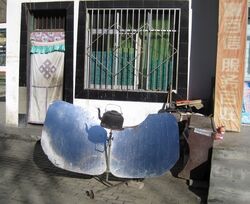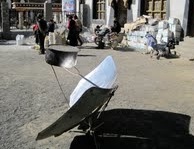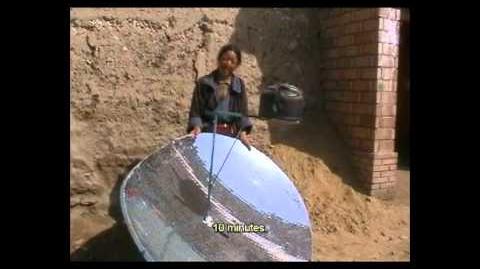Tom Sponheim (talk | contribs) Tag: sourceedit |
Tom Sponheim (talk | contribs) mNo edit summary Tag: sourceedit |
||
| (10 intermediate revisions by 3 users not shown) | |||
| Line 1: | Line 1: | ||
{{GoogleTranslateLinks}} |
{{GoogleTranslateLinks}} |
||
| − | {{Updated| |
+ | {{Updated|4|13|15}} |
| + | <table cellspacing="2"> |
||
| + | <tr> |
||
| + | <td valign="top" width="45%">__TOC__</td> |
||
| + | <td valign="top" width="55%" style="padding:9px;"> |
||
| + | [[File:Solar Cookers in Tibetan Areas of China|thumb|none|420px]] |
||
| ⚫ | |||
| + | </table> |
||
==Events== |
==Events== |
||
See [[Calendar of events]] |
See [[Calendar of events]] |
||
| + | =={{HeadingNews}}== |
||
| − | ==News and recent developments== |
||
*'''August 2013:''' Solar Cookers International Network member [[One Earth Designs]] successfully concluded its Kickstarter campaign to promote the [[SolSource]] solar cooker, raising a total of $142,413 out of a goal of $43,000 (331% of the goal) and meeting three stretch goals, with 507 people backing the project. |
*'''August 2013:''' Solar Cookers International Network member [[One Earth Designs]] successfully concluded its Kickstarter campaign to promote the [[SolSource]] solar cooker, raising a total of $142,413 out of a goal of $43,000 (331% of the goal) and meeting three stretch goals, with 507 people backing the project. |
||
| Line 16: | Line 23: | ||
{{OldNewsLink}} |
{{OldNewsLink}} |
||
| + | =={{HeadingHistory}}== |
||
| − | ==The History of Solar Cooking in China== |
||
The world's largest solar cooker programs are found in China. One contemporary |
The world's largest solar cooker programs are found in China. One contemporary |
||
spokesperson for this issue in China is [[Chen Xiaofu]], Deputy Secretary General of the |
spokesperson for this issue in China is [[Chen Xiaofu]], Deputy Secretary General of the |
||
| Line 96: | Line 103: | ||
''[Information for this section was taken originally from [[Media:sam.pdf|State of the Art of Solar Cooking]] by Dr. [[Barbara Knudson]]]'' |
''[Information for this section was taken originally from [[Media:sam.pdf|State of the Art of Solar Cooking]] by Dr. [[Barbara Knudson]]]'' |
||
{{ArchivedPagesForHistory}} |
{{ArchivedPagesForHistory}} |
||
| + | =={{HeadingClimateCulture}}== |
||
| − | ==Climate, Culture, and Special Considerations== |
||
[[Solar Cookers International]] has rated China as the #2 country in the world in terms of solar cooking potential (See: [[Media:25_countries_with_most_solar_cooking_potential.pdf|The 25 countries with the most solar cooking potential]]). The estimated number of people in China |
[[Solar Cookers International]] has rated China as the #2 country in the world in terms of solar cooking potential (See: [[Media:25_countries_with_most_solar_cooking_potential.pdf|The 25 countries with the most solar cooking potential]]). The estimated number of people in China |
||
with fuel scarcity but ample sun in 2020 is 98,100,000. |
with fuel scarcity but ample sun in 2020 is 98,100,000. |
||
| + | '''See also:''' |
||
| ⚫ | |||
| + | * {{WikipediaClimate|https://en.wikipedia.org/wiki/China#Landscape_and_climate}} |
||
| ⚫ | |||
==Clean Development Mechanism projects (Carbon credits)== |
==Clean Development Mechanism projects (Carbon credits)== |
||
| Line 150: | Line 159: | ||
===Audio and video=== |
===Audio and video=== |
||
| + | *'''June 2012:''' |
||
| ⚫ | |||
| + | ::[[File:Solar Cookers in Tibetan Areas of China|thumb|none|455px|Solar cookers shown in use in Tibetan areas of China help reduce the difficult task of gathering bushes for fuel.]] |
||
===Articles in the media=== |
===Articles in the media=== |
||
| Line 177: | Line 187: | ||
{{CountryContacts}} |
{{CountryContacts}} |
||
| ⚫ | |||
| − | ===Gallery of manufacturers and vendors=== |
||
| ⚫ | |||
| − | <gallery> |
||
| − | Image:Sangli1.jpg|[[Sangli Solar Energy]] |
||
| − | </gallery> |
||
| − | |||
| − | *[[w:c:fr.solarcooking:Four solaire parabolique "papillon"|Four solaire parabolique "papillon"]] |
||
[[Category:East Asia]] |
[[Category:East Asia]] |
||
[[Category:Asia]] |
[[Category:Asia]] |
||
| ⚫ | |||
[[Category:Countries with the greatest solar cooking potential]] |
[[Category:Countries with the greatest solar cooking potential]] |
||
| ⚫ | |||
Revision as of 20:07, 7 February 2016
|
Last edited: 13 April 2015
|
 Solar Cookers in Tibetan Areas of China Solar cookers shown in use in Tibetan areas of China help reduce the difficult task of gathering cooking fuel. |
Events
News
- August 2013: Solar Cookers International Network member One Earth Designs successfully concluded its Kickstarter campaign to promote the SolSource solar cooker, raising a total of $142,413 out of a goal of $43,000 (331% of the goal) and meeting three stretch goals, with 507 people backing the project.
- June 2013: One Earth Designs aligned with Kickstarter to promote the SolSource parabolic solar cooker. An article in gizmag explains that those wishing to help this fledgling company are offered the opportunity to purchase a cooker for $249 USD, with free shipping in the continental USA. The projected retail price will be $399 USD, so this was a great way to help them out, and get a great deal.
- February 2011: According to Yu Qing of Emmar Solar Energy, in the western part of the country, provincial and municipal governments are supporting the production of a solar stove that will be made available to farmers and herdsmen in arid mountain locations, free of charge. More Information...

A parabolic solar cooker in Tibet shown with the proud owner.

Tea water is heated with a butterfly style solar cooker in front of a local shop.

A butterfly style solar cooker at work in an open marketplace in Tibet.

Allart and his wife use their own solar trekkers backpack cooker for tea preparation while in Tibet.
- January 2011: Parabolic solar cookers popular in Tibet. Allart Ligtenberg has been involved for a number of years introducing solar cooking to communities in Nepal, Mexico, and other countries around the world. His work has given him a keen sense for perceiving the level of solar cooking happening in a particular country. He recently traveled through Tibet with his wife, and they were amazed at the number of parabolic solar cookers being used in cities and rural areas as well. Allart estimates that there may be 80,000-100,000 solar cookers in use in Tibet at this time. The cookers they saw used parabolic style reflectors, some round, others with a butterfly design. He ventured that the level of use was almost mainstream, typically for making large quantities of tea. They saw no solar box cookers or solar panel cookers. Usually, acquiring a parabolic style cooker is a more expensive approach than other solar cooking options, but he mentioned one manufacturer in China is able to market a one meter parabolic cooker for US$30-$40 due to large production numbers (100,000 units annually), and low labor costs.
History
The world's largest solar cooker programs are found in China. One contemporary spokesperson for this issue in China is Chen Xiaofu, Deputy Secretary General of the China Association for Rural Energy. He writes that China has been active in designing devices, in materials technology, in establishing technical standards for industrial production, and in dissemination and sales for over 20 years. An earlier spokesman, speaking at the First World Conference in Solar Cooking, held in 1992, provides an even longer history. Wang Xiping, a participant in that meeting in Stockton, California, outlines the use of light-collecting and focusing devices in China back into antiquity. He tell his audience that solar cooking had appeared in China before the beginning of the 20th century, with Peking duck roasted in Xiao's Duck Shop, ChengDu, China, in 1894. (Pejak,ed., 1993, p. 12).
Both gentlemen and other reporters tell of a number of efforts within China in the 1980 and 1990s. Following up on an initial meeting in 1973 on solar cooking as a new technology, the first China National Solar Energy Congress was held in 1975, a second in 1979. From initially using principally circular parabolics and simple box cookers, new and improved designs were introduced during this period, and materials for several new designs were explored and tested. In 1982, at the national level, a United Key Task Team on Solar Cooking was created, under the auspices of the Ministry of Agriculture, since the technology was particularly needed in rural areas where fuelwood was increasingly in short supply. The work of the Task Team was to begin the rigorous assessment and establishment of standards for solar cooking devices to assist consumers and policy makers in comparing the efficiency and consumer acceptability of solar stoves. Even as this was occurring, solar cooking was spreading rapidly through the countryside as the new designs emerged. The need for mechanisms to evaluate cooking equipment became clear; by 1990, National Standards for examining and testing focussing cookers were ratified by the China State Standard Agency. Over time, these beginning have led to movement from experimentation to industrial production, and from strong government support to semi-commercial dissemination strategies.
Most of the effort has been focused on rural areas. Districts with cooking fuel shortages have shown strong support for cookers using the sun's energy. Even as subsidies have been reduced, sales have continued to grow. Factories supply most of the cookers, which are made of metal or concrete, with glass as reflecting mirrors. Others are made by hand, and in both modes, new and improved designs continue to be developed and tested. Government sources continue to provide technical and financial assistance, both to active and potential manufacturers and to low income consumers, through subsidies and tax reductions.
The most recent estimate of cookers in use in China is 560,000. While there is considerable variance by region, each cooker is believed to have saved from ^600-1000 kilograms (somewhat under 300 to 500 pounds) of fuel wood per year, important benefits to both economic and environmental circumstances.
Tibet appears to be a special case in regard to solar cookers. The Solar Energy Research and Demonstration Center of Tibet, in Lhasa, indicates that approximately 70,000 solar cookers, mostly of the concentrator type, have been sold in Tibet. Initially, these sales were heavily subsidized, but that seems no longer to be the case. The cost of the devices is roughly $60, but fuel savings amortize the cost quickly. The devices are more popular in rural areas than in cities, as agriculturalists and herders are eager to save animal dung for use as fertilizer rather than as cooking fuel.
An example was seen recently by American subscribers to the National Geographic magazine. Many were startled when they opened the January, 2002, National Geographic, to find a picture of a woman making herself tea beside a modest house in the middle of China's Alashan Plateau, an isolated high natural desert in the far north of China, bordering Mongolia. The surprise was the stove she used, a mirrored solar collector. The brief story said that she was a widow of Mongolian heritage, 72 years old, living alone since the death of her husband almost 30 years ago, existing on earnings from herding camel and sheep. The lonely life meant she saw few people and had few opportunities to spend her small income. She therefore decided to invest in some "creature comfort" for herself and purchased a parabolic solar cooker for about $150. She uses it regularly to cook her meals, make tea, and prepare food for occasional visitors, in this area where the sun shines most days. She was very pleased with herself and her purchase.
Many reports of correspondence from manufacturers, research institutes, social organizations confirm the steady interest in China in solar cooking. Perhaps this interest, expertise, and promising experience with solar cookers might be harnessed in some way to assist other nations of the region.
To that end, a September 1994 International Solar Energy Applications Training Workshop was held for citizens of other Asian nations, sponsored by the National Energy Research Institute of Gansu Province, Academy of Science, and aided by the Ministry of Foreign Trade and Economic Cooperation. The workshop is one excellent model for dissemination of the technology in Asia. China was also represented among those demonstrating solar cooking at the 2002 Johannesburg World Social Summit.
[Information for this section was taken originally from State of the Art of Solar Cooking by Dr. Barbara Knudson]
- Main article: History of solar cooking
Archived articles
Climate and culture
Solar Cookers International has rated China as the #2 country in the world in terms of solar cooking potential (See: The 25 countries with the most solar cooking potential). The estimated number of people in China with fuel scarcity but ample sun in 2020 is 98,100,000.
See also:
Clean Development Mechanism projects (Carbon credits)
- Main article: Clean Development Mechanism
- Federal Intertrade Hong-Ru River Solar Cooker Project
- Federal Intertrade Pengyang Solar Cooker Project
Resources
Websites
Reports
- April 2014: Market Research Report on Global and Chinese Solar Cooker Industry, 2009-2019 (report costs USD$2400)
- February 15, 2014: SOLAR COOKING IN CHINA: CDM Registered Projects - Trish Sheehan (Solar Household Energy)
- April 2009: Development and Application of Solar Cooker in China (International Solar Food Processing Conference 2009)
- April 2009: Numerous solar cooker projects have been implemented in Qinghai, Gansu, and Sichuan. These projects were mostly done by Tibetan students at Qinghai Normal University. Also see these documents:
- http://www.archive.org/details/185SolarCookersFor185TibetanHouseholdsInSasumaAndDunpengVillages
- http://www.archive.org/details/SolarCookersForXiangshaAndLamuTibetanVillagers
- http://www.archive.org/details/140SolarCookersForThuwaTsangAndAgongChunwathuwaTsangTibetanVillages
- http://www.archive.org/details/SolarCookersForRuralTibetansInGansuProvincePrChina
- http://www.archive.org/details/43SolarCookersForHualongkouVillage
- The detailed nature of the final reports in .pdf format gives insight into village conditions, the cost of solar cookers, and the amount of local contributions for the solar cookers.
- November 2007: Solarkocherprojekt Alcan in der Provinz Ningxia/China Bericht über die Reise vom 10. Nov. bis 17. Nov. 2007 - Dieter Seifert (original German text with photos), Solar Cooker Project Alcan in the province of Ningxia / China: Report from the visit from 10 November to 17 November 2007 - Dieter Seifert (English translation)
- February 2007: Solar Cookers for Heluoshi Village - Shem Women's Group
- December 2006: Solar Cookers for Yehe Village - Shem Women's Group
- July 2006: The Solar Cooker Development and Application in China - Chen Xiaofu and Han Tingcun
- April 2006: Solar Cookers for Tawa Gongma Nunnery - Shem Women's Group
- February 2005: The Development and Application of Solar Cookers in China - Chen Xiaofu
Audio and video
- June 2012:
Articles in the media
- October 2011: Eating China Part IV: Tibetan Cuisine - Epicurious.com
- August 2011: Hong Kong’s First Solar-Cooking Day at SHKP’s Ma Wan Park: Local Families Promote Use of Renewable Energy - Sun Hung Kai Properties
- June 2009: China and Kenya setting up a joint venture for solar energy products - Chinaafrica.asia
- May 2009: SolSource 3-in-1: An Alternative Energy Solution - WorldChanging
- February 2009: Senior wins Gates scholarship - MIT News
- July 2008: Utah native utilizing sun's rays in Asia - Deseret News
- June 2008: Portable Solar Cookers For Tibet - Lucky!
- March 2008: Black carbon pollution emerges as major player in global warming - Scripps Institution of Oceanography
- July 2007: Solar-powered ovens revolutionize cooking - Operation Blessing
- November 2006: Chinese company makes, exports thousands of solar cookers
External links
Contacts
The entities listed below are either based in China, or have established solar cooking projects there:
SCI Associates
- Main article: Solar Cookers International Association
NGOs
Manufacturers and vendors
Individuals
Government agencies
Educational institutions
See also
- 2013 World Bank Assessment of Solar Cooking in China
- Category:Anhui
- Ao Chi Solar Cooker
- Butterfly
- China news archive
- Category:Gansu
- Category:Guangdong
- Category:Hong Kong
- Category:Jiangsu
- Category:Municipality of Beijing
- Provinces of the People's Republic of China
- Category:Provinces of the People's Republic of China
- Category:Qinghai
- Category:Shandong
- Category:Tianjin
- Category:Tibet
- Category:Xining
- Category:Zhejiang

